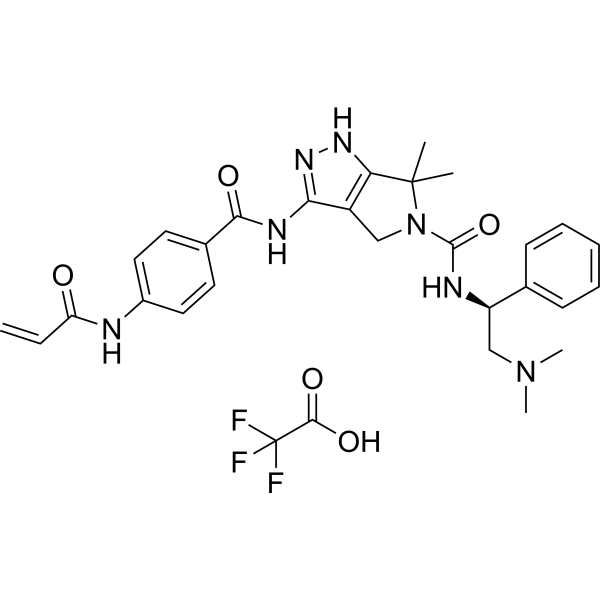Physicochemical Properties
| Molecular Formula | C30H34F3N7O5 |
| Molecular Weight | 629.630076885223 |
| Exact Mass | 629.257 |
| CAS # | 2748220-93-9 |
| Related CAS # | YKL-5-124;1957203-01-8 |
| PubChem CID | 146025947 |
| Appearance | White to off-white solid powder |
| Hydrogen Bond Donor Count | 5 |
| Hydrogen Bond Acceptor Count | 10 |
| Rotatable Bond Count | 8 |
| Heavy Atom Count | 45 |
| Complexity | 948 |
| Defined Atom Stereocenter Count | 1 |
| SMILES | C(F)(F)(F)C(=O)O.N(C1=NNC2C(C)(C)N(C(=O)N[C@@H](C3C=CC=CC=3)CN(C)C)CC1=2)C(C1C=CC(NC(=O)C=C)=CC=1)=O |
| InChi Key | CPYGDECNKKKQGE-VZYDHVRKSA-N |
| InChi Code | InChI=1S/C28H33N7O3.C2HF3O2/c1-6-23(36)29-20-14-12-19(13-15-20)26(37)31-25-21-16-35(28(2,3)24(21)32-33-25)27(38)30-22(17-34(4)5)18-10-8-7-9-11-18;3-2(4,5)1(6)7/h6-15,22H,1,16-17H2,2-5H3,(H,29,36)(H,30,38)(H2,31,32,33,37);(H,6,7)/t22-;/m1./s1 |
| Chemical Name | N-[(1S)-2-(dimethylamino)-1-phenylethyl]-6,6-dimethyl-3-[[4-(prop-2-enoylamino)benzoyl]amino]-1,4-dihydropyrrolo[3,4-c]pyrazole-5-carboxamide;2,2,2-trifluoroacetic acid |
| HS Tariff Code | 2934.99.9001 |
| Storage |
Powder-20°C 3 years 4°C 2 years In solvent -80°C 6 months -20°C 1 month Note: Please store this product in a sealed and protected environment, avoid exposure to moisture. |
| Shipping Condition | Room temperature (This product is stable at ambient temperature for a few days during ordinary shipping and time spent in Customs) |
Biological Activity
| Targets | CDK7 53.5 nM (IC50) CDK7/Mat1/CycH 9.7 nM (IC50) CDK2 1300 nM (IC50) CDK9 3020 nM (IC50) |
| ln Vitro | G1- and G2/M-phase cell numbers rise while S-phase cell numbers decrease in a dose-dependent manner in response to YKL-5-124 (0-2000 nM; 72 hours; HAP1 cells) treatment[1]. ?In a concentration-dependent manner, YKL-5-124 (0-2000 nM; 24 hours; HAP1 WT cells) treatment suppresses the phosphorylation of CDK1 T-loop and, to a lesser extent, CDK2 T-loop[1]. ?The pull-down of CDK7-cyclin H is blocked when cells treated with YKL -5-124 as a competitor at a concentration of roughly 30 nM, but it has no effect on the pull-down of cyclin K-CDK12/13 in HAP1 cells. CDK7-cyclin H binding to bioTHZ1 is reduced by >50% after 30 minutes of treatment with 100 nM YKL-5 -124[1]. |
| Cell Assay |
Cell Cycle Analysis[1] Cell Types: HAP1 cells Tested Concentrations: 0 nM, 0.2 nM, 0.7 nM, 2 nM, 6.3 nM, 20 nM, 60 nM, 200 nM, 633.3 nM, 2000 nM Incubation Duration: 72 hrs (hours) Experimental Results: Caused a dose-dependent increase in G1- and G2/M-phase cells and a corresponding loss of S-phase cells. Western Blot Analysis[1] Cell Types: HAP1 WT cells Tested Concentrations: 0 nM, 125 nM, 250 nM, 500 nM, 1000 nM, 2000 nM Incubation Duration: 24 hrs (hours) Experimental Results: Inhibited CDK1 T-loop phosphorylation, and to a lesser extent CDK2 T-loop phosphorylation in a concentration-dependent fashion. |
| References |
[1]. Development of a Selective CDK7 Covalent Inhibitor Reveals Predominant Cell-Cycle Phenotype. Cell Chem Biol. 2019 Jun 20;26(6):792-803.e10. |
Solubility Data
| Solubility (In Vitro) |
DMSO: ≥ 100 mg/mL (158.82 mM) H2O: 50 mg/mL (79.41 mM) |
| Solubility (In Vivo) |
Solubility in Formulation 1: ≥ 2.5 mg/mL (3.97 mM) (saturation unknown) in 10% DMSO + 40% PEG300 + 5% Tween80 + 45% Saline (add these co-solvents sequentially from left to right, and one by one), clear solution. For example, if 1 mL of working solution is to be prepared, you can add 100 μL of 25.0 mg/mL clear DMSO stock solution to 400 μL PEG300 and mix evenly; then add 50 μL Tween-80 to the above solution and mix evenly; then add 450 μL normal saline to adjust the volume to 1 mL. Preparation of saline: Dissolve 0.9 g of sodium chloride in 100 mL ddH₂ O to obtain a clear solution. Solubility in Formulation 2: ≥ 2.5 mg/mL (3.97 mM) (saturation unknown) in 10% DMSO + 90% (20% SBE-β-CD in Saline) (add these co-solvents sequentially from left to right, and one by one), clear solution. For example, if 1 mL of working solution is to be prepared, you can add 100 μL of 25.0 mg/mL clear DMSO stock solution to 900 μL of 20% SBE-β-CD physiological saline solution and mix evenly. Preparation of 20% SBE-β-CD in Saline (4°C,1 week): Dissolve 2 g SBE-β-CD in 10 mL saline to obtain a clear solution. Solubility in Formulation 3: ≥ 2.5 mg/mL (3.97 mM) (saturation unknown) in 10% DMSO + 90% Corn Oil (add these co-solvents sequentially from left to right, and one by one), clear solution. For example, if 1 mL of working solution is to be prepared, you can add 100 μL of 25.0 mg/mL clear DMSO stock solution to 900 μL of corn oil and mix evenly. Solubility in Formulation 4: 50 mg/mL (79.41 mM) in PBS (add these co-solvents sequentially from left to right, and one by one), clear solution; with ultrasonication. (Please use freshly prepared in vivo formulations for optimal results.) |
| Preparing Stock Solutions | 1 mg | 5 mg | 10 mg | |
| 1 mM | 1.5882 mL | 7.9412 mL | 15.8823 mL | |
| 5 mM | 0.3176 mL | 1.5882 mL | 3.1765 mL | |
| 10 mM | 0.1588 mL | 0.7941 mL | 1.5882 mL |
